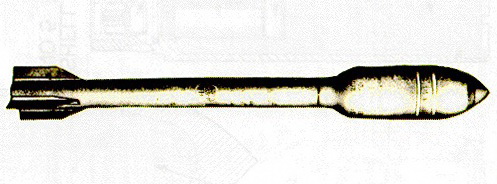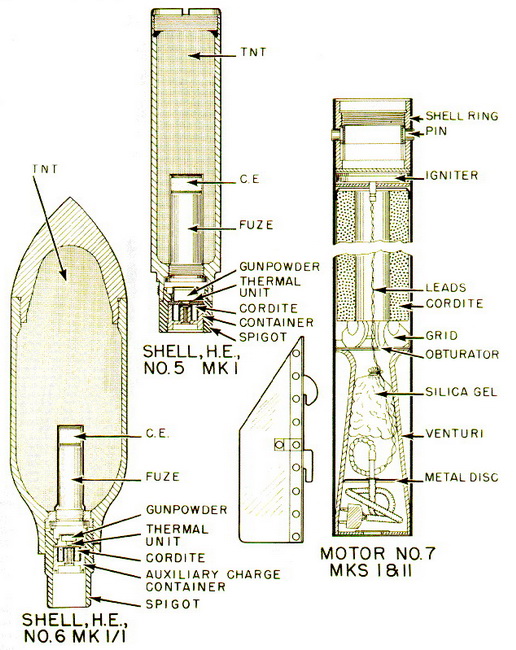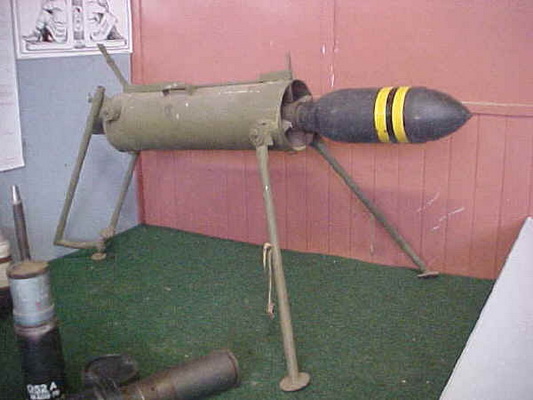|
|
| BRITISH EXPLOSIVE ORDNANCE |
| Part 3 - Chapter 2 |
| High-Explosive Rockets |
|
3-in. Assault Rocket "Lilo" (Service) |
| Data |
| H.E. Shells | 21 lb. No. 5 | 60 lb. No. 6 |
|
Over-all length |
14.25 in. | 17.50 in. |
|
Diameter |
3.25 in. | 6.0 in. |
|
Total weight |
21 lb. | 60 lb. |
|
Fuzing |
No. 297 Mk I | No. 297 Mk I |
|
Explosive |
TNT | TNT |
|
Explosve weight |
4 lb. |
16.75 lb. |
| Rocket Motor | ||
|
Over-all length |
34.5 in. | |
|
Diameter |
3.25 in. | |
|
Width of fins |
1.75 in. (approx.) | |
|
Total weight |
18.25 lb. | |
|
Propellant |
Cog-shaped, cordite | |
|
Propellant weight |
4.25 lb. | |
|
Burning time at 60° F. |
0.5 sec. |
|
|
General: This rocket is designed as a heavy offensive weapon for infantry use against lightly reinforced obstacles. Only small fins are provided on the rocket motor, so stabili-zation in flight has been achieved by incorporating spiral rails in the interior of the laun-cher body. The rocket is fired from a small portable launcher by means of a light dry-cell battery, a U.S. Army 10 cap exploder, or a U.S. Navy "Magnavox" firing key. |
|
Description |
|
Shell, H.E., 21-lb. No. 5 Mk I – This shell consists of a steel cylinder closed at the for-ward end by a flat steel nose plug. The after end is externally threaded and reduced in diameter to screw into the shell ring of the rocket motor. A steel spigot is threaded into the after end of the shell body and contains the cordite filled auxiliary charge container. Separated from the auxiliary cordite charge by a thin steel plate are a small thermal unit and a gunpowder pellet. Beneath this pellet the base percussion Fuze No. 297 Mk I is threaded directly into the shell body. A single C.E. exploder pellet is located beneath the fuze in a cardboard exploder container. |
|
Shell, H.E., 60-lb. No. 6 Mk I – The 60-lb. shell contains a Fuze No. 297 and an auxi-liary charge container almost identical to that incorporated in the 21-lb. shell. A slightly different spigot arrangement is employed, however, as the spigot itself is externally threaded for attachment to the shell ring of the rocket motor. The nose portion of the shell is ogival and threads into the cylindrical shell body portion. |
|
Motor, Rocket, 3-in., No. 7 Mks I and II – The motor consists of a steel tube fitted with a shell ring at one end and at the other with a venturi tube. The threaded shell ring is held in position by eight locking pins engaged by a circular band spring. |
|
The venturi is welded to the inside of the motor body. A steel grid, separated from the venturi tube by the tail obturator, supports the cog-shaped cordite propellant grain. A metal closing disc in the venturi tube supports the igniter leads, which terminate in a two-pronged plug. The after end of the venturi is sealed by a cardboard closing disc. The igniter leads extend from the plug through the central annulus of the propellant grain to the metal igniter housing, which contains a small electric squib surrounded by a charge of gunpowder. Behind the metal closing disc in the venturi is located a bag of si-lica gel as a moisture-proofing measure. |
|
The four fins are assembled to the motor by engaging their hooks in the fin slots in the after end of the motor body and pressing home the locking catches on the fins. A 10-yard extension cable is provided with each motor for firing purposes, thus allowing personnel to take cover when firing occurs. The extension is plugged at one end and contains a two-hole socket at the other for attachment to the plug connected to the igniter leads of the motor. |
|
The motor must not be fired outside the temperature range of -5° to 135° F. |
|
Remarks: The shells are painted buff over-all with a ½-in. red band around the nose and a 1-in. light green band around the body. On this latter band are stencilled in black letters of the explosive filling. Two thin white bands are painted around the body on either side of the light green band. |
 |
| Figure 186 – Assembled 3-in. Assault Rocket |
 |
| Figure 187 – 3-in. Assault Rocket Components |
 |